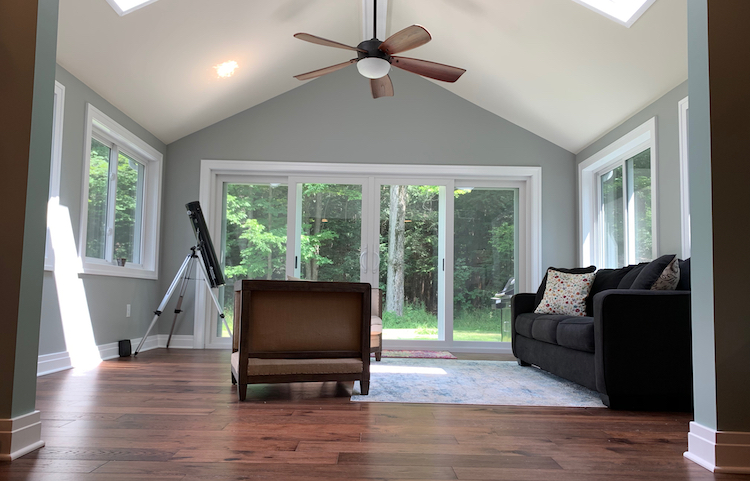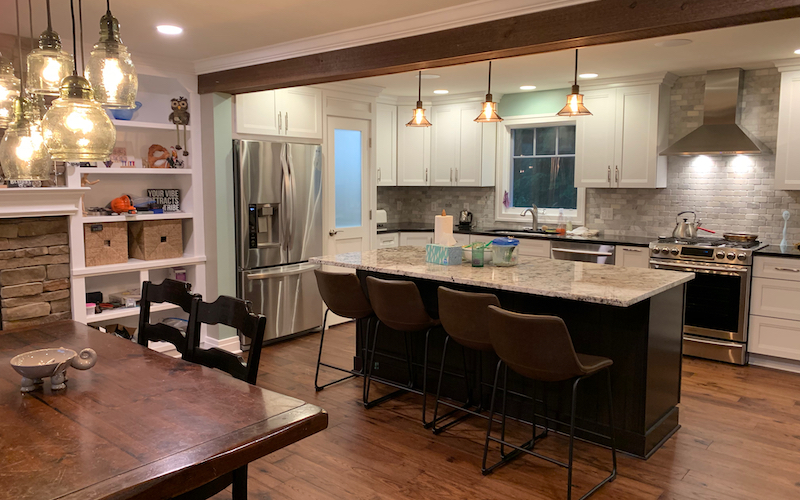Making a House a Home
What makes a house a home?
A home is a representation – a reflection – of who you are and of who your family is. It is a place where you should feel free to be yourself; somewhere you feel comfortable and safe. It is your hive, your intimate space.
Over the past 19 years, my family has lived in three homes – the current one being a short sale from the bank that we then remodeled ourselves. Nine years, two kids, and a dog later, the house needed a bit more love, so in April of this year we began a remodel of almost our entire first floor. The renovation would include our entryway, kitchen, a new window in our dining room, a façade upgrade of our front patio, and turning a three-season room into another room of our home.
Although building and remodeling are about product and structure, it should also be about your quality of life. From the style you choose to the paint colors and furniture that you pick, your finished product should make you feel the way you want to feel at home. The technology in the home should add that last layer of comfort but is often forgotten about or becomes an afterthought.
Today there is more evidence than ever before on how lighting and music can change your mood, even lower your blood pressure and calm the kids. According to the Environmental Protection Agency, “Americans, on average, spend approximately 90 percent of their time indoors.” And this messes with our circadian rhythm, a 24-hour internal clock that controls sleep-wake cycles as well as metabolism, cognition, and more. How could we use technology in my own home for more than entertainment…to improve the family’s well-being?
For the first time, I was forced to look at adding technology from the user’s perspective and not from a sales perspective, as the owner of a technology integration firm. I have always believed that I have done an excellent job at putting myself in my customer’s shoes, but until you are forced to make these decisions for your lifestyle, you do not have a real appreciation of what it is like to live with these experiences.
Music
A few years ago, Sonos surveyed 30,000 people across the world and also went into 30 homes in eight different countries to see, hear, and track what happens when people don’t listen to music, and also what changes when they do. What they found was, music doesn’t just help households; it transforms them. “The songs, playlists, and albums become a connector – a magnet pulling you back to the good life. You’re together more. You’re happy more. You love (and make love) more.”
Music was a must in our home. We understand not just the need for music, but for the need for good-quality sound and the importance of individual volume control of separate rooms. For this reason, we installed four Paradigm Elite speakers in the kitchen and two in the dining room. The new sun room proved more challenging for speaker placement, as the room is composed of four large windows and a four-panel sliding glass door. Adding speakers to the ceiling would not be an option because it was not being refinished.
When it is your own house, perhaps you’re willing to be more unconventional. I retrieved my Sonos beam, which I usually kept in my bedroom, and slid it under the couch, then used Sonos Trueplay Tuning. It should be muffled (being under a sofa), but, instead, it sounded impressive for background music. The best part is, you can’t see a speaker anywhere in the room.
We often recommend Paradigm CI Home Series speakers to our clients and CI Pro when they request a step up, and they sound great. My clients have always been thrilled. However, since I do this for a living, treating myself to the Elites and matching them with Sonos’ new higher-powered amplifiers was stunning. They rock! Not only does the audio sound great when blasting your favorite song, but the detail at every volume is delicious.
Of course, we can control the audio via the Sonos app, but also by requesting Alexa, we can play the music in the room of our choosing. We also have programmed a central keypad to control volume up and down.

Lighting
Lighting is perhaps the most overlooked “quality of life” technology portion of the home. We all know in some fundamental way that light affects our mood. This is why we find beauty in a sunset, why we sleep better in the full darkness, and why we are happier on sunny days over dreary ones. And yet, when it comes to lighting out homes, we often buy the most economical fixture or bulb. We turn on harsh lights when we first awaken and wonder why we are cranky. We flip multiple switches trying to find the right light, and we clutter our walls with controls.
Our house is run by Crestron Pyng – a user-friendly control system from the most established automation company in the business. This system allows for control of audio, lighting, shades, thermostats, door locks, and security systems.
Each room in our home has only one control point (a push-button keypad) to turn lights on and off. The top button in each area turns on lights in that space to a pre-determined setting and then by pressing and holding that button, the room will turn up or down. The goal was for even fewer “button pushes,” so in our home the kitchen turns on at dawn to only 25 percent. This allows enough light to get to my coffee percolator to begin my morning brew. If I need more light, then pressing the button will bring the light up to a brighter setting to start my day.
Voice commands add another layer of control and simplicity to our home. If I’m working in the kitchen, I can ask Alexa to turn on/off the pantry light or to turn the kitchen lights to 90 percent, if I’m in the middle of preparing dinner. Our front porch lights turn on at dusk and off at dawn. We also have a path in the house that turns on at dusk, so we never walk into a dark home.
This project forced me to understand color temperature and how today’s LEDs work. I had never been a fan of LED due to the cool blue light that they tend to emit, not understanding that “color temperature” is a purchasing choice. After a bit of research, however, we discovered high CRI (color rendering index) LEDs that fit into our desired lifestyle. Leading hectic lifestyles, we wanted our home to be an escape, so warm color rendering (above 90) was critical. Our fixtures also had to be able to dim as well; you will rarely find a light at 100 percent in this household.
Security
We enter the house using a numeric code, instead of a traditional key, via our Yale keypad lockset. A command locking the deadbolt will trigger at midnight if the door is not already locked. The app on our phones will also allow us to lock and unlock the door. We live in a smaller suburb, so no video doorbell was warranted. If desired, we could also set up alert notifications to tell us when someone has entered the house – like the kids returning home from school.
Shades
One of our splurges was the dining room window. While beautiful, it has always been like a TV screen for all the neighbors to view our life after dark. Finding a drape that would not take away from the top window mullions but provide some much-needed acoustic absorption proved difficult. The final product, yet to be installed, will provide privacy when needed and become part of the home system – opening at 7:30 am during the week and at 10 a.m. on the weekends and closing at dark.
Control
As mentioned, Crestron Pyng is the hub of the home (with a Crestron Home interface update coming soon). Why a single operating system instead of separate apps? We desired seamless integration allowing for scenes, not just control of a light or fixtures. Having multiple apps on a smartphone is no different than numerous remotes sitting on the coffee table, and no one understanding how to work the system. On one keypad we can have a lighting scene and music controls. Via voice control, we can ask Alexa to set the temperature of the home to that of our choosing.
Other technology tidbits in the home include a charging drawer in the kitchen that allows us to keep the technology clutter hidden. A Smart Art Frame by Meural hangs in the dining room, teaching the family about art while providing beauty to the room. Art changes every few minutes. Finally, a system is only as good as the network, so make sure your Wi-Fi throughout the home is solid. Our system is by Ubiquiti.
We can keep growing our system as our lifestyles change. We can add more lighting control by just changing out a dimmer or switch. We can add media control should we decide to put a TV in the sunroom. It’s one system to coordinate all of our experiences today, tomorrow, and beyond.
So, back to the original question: When does a house become a home? Well, my kitchen is big enough to dance in, my music keeps me sane, my lights calm me and keep the house secure, our shades will cocoon us during our sleepy hours, and our door will keep itself locked. Yes, our house is our home thanks to some fantastic contractors, creative design, and a layer of technology that improves our quality of life – our well-being.





![Hub 3_02 The SwitchBot Hub 3 provides a user-friendly solution to the growing complexity of modern smart homes. [Photo credit | SwitchBot]](https://restechtoday.com/wp-content/uploads/2025/06/Hub-3_02-scaled-e1750179791687.png)


